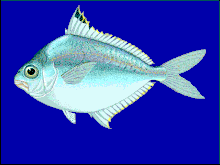Leiognathidae
| Leiognathidae Temporal range: 56–0 Ma Eocene to Present |
|
|---|---|
 |
|
| Eubleekeria splendens | |
| Scientific classification | |
| Kingdom: | Animalia |
| Phylum: | Chordata |
| Class: | Actinopterygii |
| Order: | Perciformes |
| Family: |
Leiognathidae T. N. Gill, 1893 |
| Genera | |
Leiognathidae, the ponyfishes, slipmouths or slimys / slimies, are a small family of fishes in the order Perciformes. They inhabit marine and brackish waters in the Indian and West Pacific Oceans. They can be used in the preparation of bagoong.
Ponyfishes are small and laterally compressed in shape, with a bland, silvery colouration. They are distinguished by highly extensible mouths, and the presence of a mechanism for locking the spines in the dorsal and anal fins. They also possess a highly integrated light organ in their throats that houses symbiotic bioluminescent bacteria that project light through the animal's underside. Typically, the harbored bacterium is only Photobacterium leiognathi, but in the two ponyfish species Photopectoralis panayensis and Photopectoralis bindus, Photobacterium mandapamensis is also present. Two of the most widely studied uses for luminescence in ponyfish are camouflage by ventral counterillumination and species-specific sexual dimorphism.
Although ponyfish seem quite ordinary and morphologically similar, their light organ systems are highly variable across species and often between sexes.
...
Wikipedia
